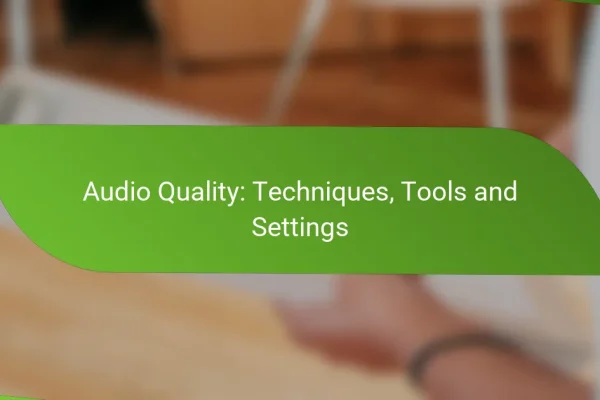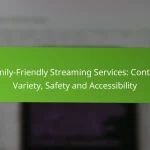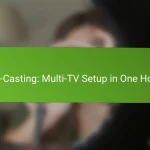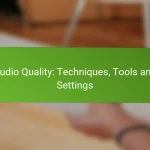How to Choose the Right Self-Casting Equipment?
Selecting the right self-casting equipment is crucial for achieving high-quality broadcasts. Focus on key components like microphones, cameras, lighting, and software to enhance your streaming experience.
Microphones for Self-Casting
A good microphone is essential for clear audio during your self-casting sessions. Consider options like USB microphones for simplicity or XLR microphones for professional quality, which require an audio interface.
Look for features such as noise cancellation and adjustable gain to improve sound quality. Popular choices include the Blue Yeti for USB and the Shure SM7B for XLR setups.
Cameras for High-Quality Streaming
Your camera choice significantly impacts the visual quality of your stream. Webcam options like the Logitech C920 offer great performance for beginners, while mirrorless cameras provide superior image quality for more advanced users.
Ensure your camera supports at least 1080p resolution and has good low-light performance. Using a capture card can help connect a DSLR or mirrorless camera to your streaming setup.
Lighting Options for Better Visibility
Proper lighting is vital for a professional-looking stream. Softbox lights and ring lights are popular choices that provide even illumination and reduce harsh shadows.
Consider adjustable brightness and color temperature features to match your environment. Position your lights at a 45-degree angle to your face for optimal results.
Streaming Software Recommendations
Choosing the right streaming software can enhance your self-casting experience. OBS Studio is a free, open-source option that offers extensive customization, while Streamlabs OBS is user-friendly and great for beginners.
Evaluate features like scene transitions, overlays, and chat integration to find software that meets your needs. Ensure compatibility with your chosen platform, whether it’s Twitch, YouTube, or another service.
Accessories for Enhanced Experience
Accessories can significantly improve your self-casting setup. Consider investing in a good quality tripod for stable camera positioning and a pop filter for your microphone to reduce plosive sounds.
Other useful accessories include a green screen for background effects and a stream deck for easy control of your broadcast. These tools can streamline your workflow and elevate your overall production quality.
What Techniques Improve Self-Casting Quality?
Improving self-casting quality involves optimizing audio, video, and audience engagement techniques. By focusing on these areas, you can create a more professional and engaging experience for your viewers.
Audio Mixing Techniques
Effective audio mixing is crucial for self-casting. Use a good quality microphone and consider investing in an audio interface to enhance sound clarity. Aim for balanced levels, ensuring that your voice is clear and not overshadowed by background noise.
Utilize software tools to adjust levels and apply filters. For instance, a noise gate can help eliminate unwanted sounds, while equalization can enhance vocal quality. Regularly monitor audio levels during your stream to maintain consistency.
Video Framing Best Practices
Proper video framing enhances viewer engagement. Position your camera at eye level and ensure you are centered in the frame. A common rule is to follow the “rule of thirds,” placing your eyes along the top third of the screen for a more appealing composition.
Lighting is equally important; natural light works well, but softbox lights can provide even illumination. Avoid backlighting, which can create shadows on your face. Test your setup before going live to ensure everything looks professional.
Engagement Strategies for Audience Interaction
Engaging your audience is key to a successful self-casting experience. Start by greeting viewers as they join and encourage them to participate through comments or questions. Use interactive tools like polls or Q&A sessions to foster a sense of community.
Consider setting aside specific times during your stream to address audience questions or feedback. This not only keeps viewers engaged but also makes them feel valued. Regularly remind your audience to like, share, or subscribe to enhance your reach.
What Are Common Challenges in Self-Casting?
Self-casting presents several challenges that can affect the overall experience and quality of the broadcast. Common issues include technical difficulties, managing audience feedback, and overcoming performance anxiety.
Technical Issues and Troubleshooting
Technical issues can range from poor internet connectivity to software malfunctions. Ensuring a stable internet connection with a speed of at least 5 Mbps is crucial for smooth streaming. Regularly updating your software and hardware can prevent many common problems.
When troubleshooting, check your equipment setup, including microphones and cameras, to ensure they are functioning correctly. Having backup equipment, like a secondary microphone or camera, can save a broadcast if primary tools fail.
Managing Live Audience Feedback
Live audience feedback can be both a motivator and a distraction. It is essential to establish a system for monitoring comments and questions without losing focus on the content being presented. Designating a moderator can help manage interactions effectively.
Consider setting specific times during the broadcast to address audience questions. This approach allows you to maintain the flow of your presentation while still engaging with viewers, enhancing their experience.
Overcoming Performance Anxiety
Performance anxiety is a common challenge for many self-casters, often stemming from the fear of judgment or making mistakes. Practicing your presentation multiple times can help build confidence and reduce nervousness.
Incorporating relaxation techniques, such as deep breathing or visualization, can also be beneficial. Remember that mistakes are a natural part of live broadcasting, and viewers often appreciate authenticity over perfection.
What Are the Costs Involved in Self-Casting?
The costs involved in self-casting can vary widely based on equipment, software, and potential revenue. Understanding these expenses is crucial for budgeting and maximizing your investment in self-casting.
Equipment Investment Breakdown
Investing in the right equipment is essential for a successful self-casting experience. Basic setups typically include a good-quality camera, microphone, and lighting, which can range from a few hundred to several thousand dollars depending on the quality and brand.
For example, a decent webcam might cost around $100, while professional cameras can exceed $1,000. Additionally, consider accessories like tripods and soundproofing materials, which can add another few hundred dollars to your initial investment.
Software Subscription Costs
Software costs can also impact your self-casting budget. Many platforms offer subscription-based services for streaming and editing, with prices generally ranging from $10 to $50 per month.
Popular options include OBS Studio, which is free, and more advanced tools like Adobe Premiere Pro, which may require a monthly fee. Evaluate your needs to choose software that balances functionality and cost-effectiveness.
Potential Revenue Streams
Self-casting can open various revenue opportunities, including ad revenue, sponsorships, and viewer donations. Many self-casters monetize their content through platforms like Twitch or YouTube, where they can earn money based on views and subscriptions.
Additionally, consider affiliate marketing or merchandise sales as potential income sources. Building a loyal audience can significantly enhance your earning potential over time.
How to Promote Your Self-Casting Content?
Promoting your self-casting content effectively involves leveraging various platforms and strategies to reach a wider audience. Focus on engaging with your viewers and creating shareable content that resonates with your target demographic.
Social Media Strategies
Utilizing social media platforms is crucial for promoting your self-casting content. Platforms like Instagram, Twitter, and TikTok can help you share snippets of your streams, behind-the-scenes moments, and engage with your audience directly.
Consider creating a content calendar to maintain a consistent posting schedule. Use relevant hashtags to increase visibility and encourage your followers to share your content. Engaging with comments and messages can also foster community and loyalty.
Collaborations with Other Streamers
Collaborating with other streamers can significantly boost your visibility. Partnering with those who have a similar or larger audience can introduce your content to new viewers who may be interested in your style.
Look for opportunities to co-stream, participate in joint events, or feature each other in your content. This not only diversifies your audience but also enriches your content through shared experiences and insights.
Utilizing SEO for Discoverability
Search Engine Optimization (SEO) is essential for making your self-casting content more discoverable. Use keywords related to your niche in your titles, descriptions, and tags to improve your chances of appearing in search results.
Consider creating a blog or website to host your content, where you can optimize for search engines. Regularly updating your content and using analytics tools can help you understand what works best for attracting viewers.
What Are the Future Trends in Self-Casting?
Future trends in self-casting are increasingly focused on enhancing user experience through technology and personalization. Innovations such as AI-driven content creation and improved streaming quality are set to shape how individuals engage with self-casting platforms.
Increased Use of AI and Automation
AI and automation are becoming integral to self-casting, enabling users to create content more efficiently. Tools that analyze audience preferences and optimize content delivery can help streamline the casting process. For instance, AI can suggest the best times to broadcast based on viewer engagement data.
As these technologies evolve, users can expect more personalized experiences, with automated features that tailor content to specific demographics. This shift may lead to higher viewer retention and engagement rates.
Enhanced Streaming Quality
Streaming quality is set to improve significantly, driven by advancements in internet speeds and video compression technologies. Users will benefit from higher resolution streams, which can enhance the overall viewing experience. For example, 4K streaming is becoming more accessible, allowing for clearer and more vibrant visuals.
Moreover, platforms are likely to adopt adaptive bitrate streaming, which adjusts video quality based on the viewer’s internet connection. This ensures a smoother experience, reducing buffering and interruptions during live broadcasts.
Greater Emphasis on Community Engagement
Community engagement is becoming a focal point in self-casting, with platforms introducing features that foster interaction between creators and their audiences. Live chat options, polls, and Q&A sessions can enhance viewer participation and create a sense of belonging.
Building a strong community can lead to increased loyalty and support for content creators. Engaging with viewers through social media and dedicated forums can further strengthen these connections, making audiences feel valued and heard.
Focus on Monetization Strategies
As self-casting gains popularity, monetization strategies are evolving to provide creators with sustainable income sources. Subscription models, merchandise sales, and sponsorship deals are becoming common ways for creators to monetize their content.
Platforms may also introduce new revenue-sharing models that benefit both creators and the platform itself. Understanding these options can help creators choose the best strategies to maximize their earnings while maintaining audience trust.












